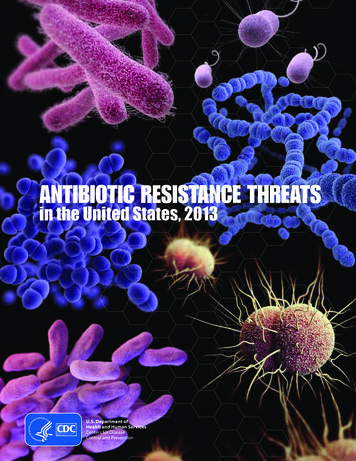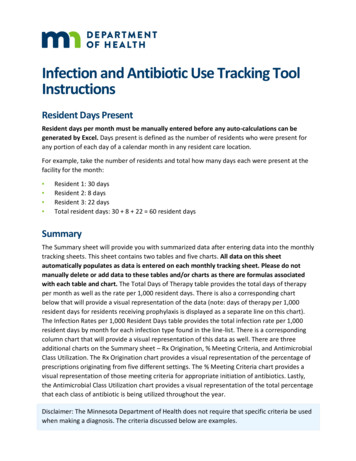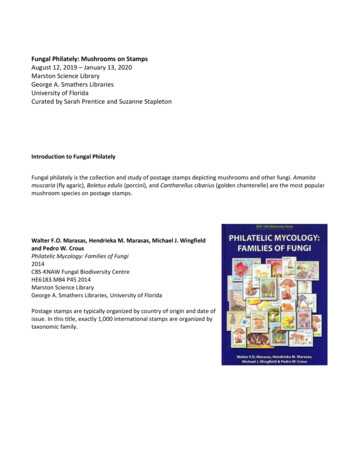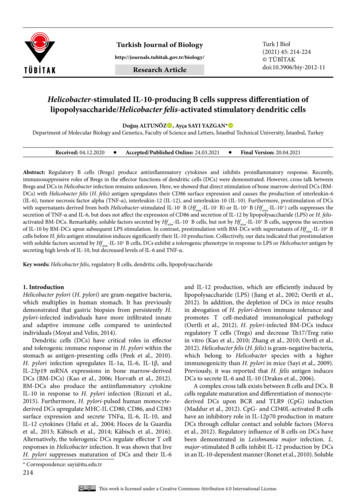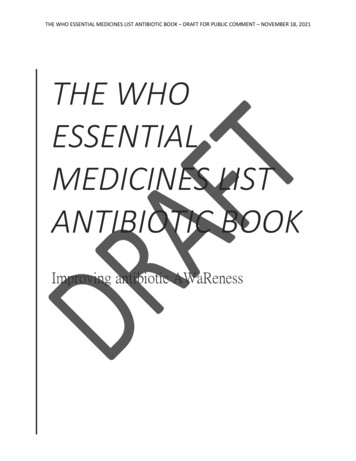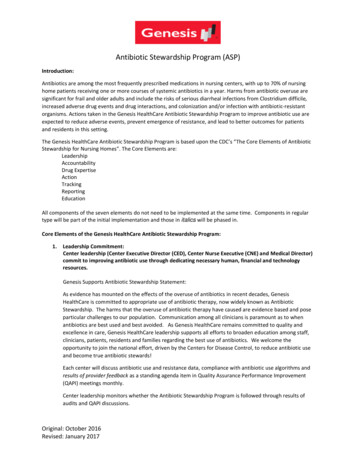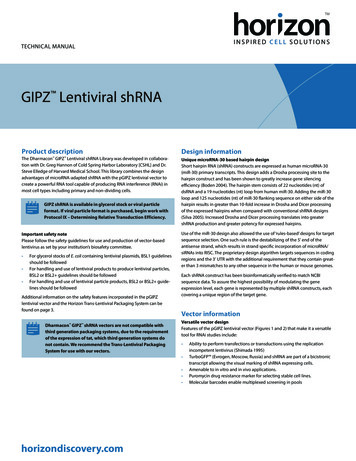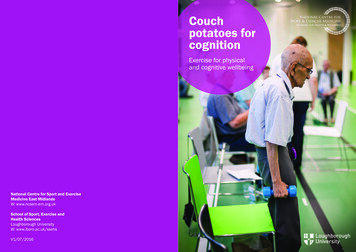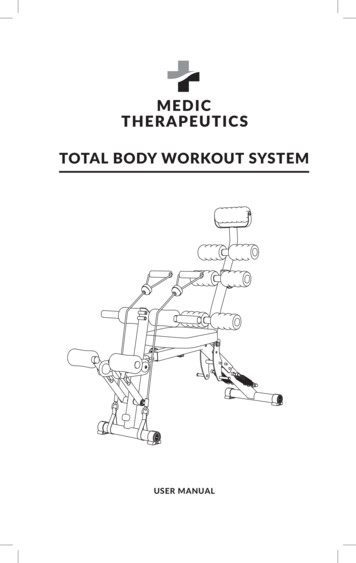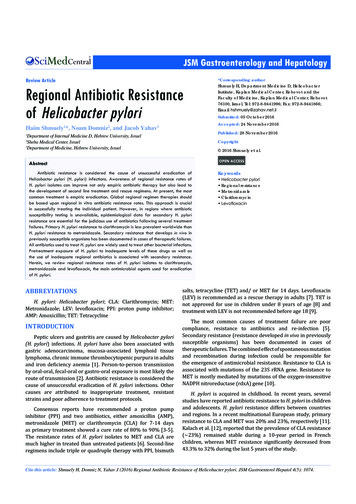
Transcription
Central Bringing Excellence in Open AccessJSM Gastroenterology and HepatologyReview ArticleRegional Antibiotic Resistanceof Helicobacter pyloriHaim Shmuely1*, Noam Domniz2, and Jacob Yahav3*Corresponding authorShmuely H, Department Medicine D, HelicobacterInstitute, Kaplan Medical Center, Rehovot and theFaculty of Medicine, Kaplan Medical Center, Rehovot76100, Israel, Tel: 972-8-9441996; Fax: 972-8-9441866;Email:Submitted: 05 October 2016Accepted: 24 November 2016Published: 28 November 20161Department of Internal Medicine D, Hebrew University, IsraelSheba Medical Center, Israel3Department of Medicine, Hebrew University, IsraelCopyright2 2016 Shmuely et al.AbstractOPEN ACCESSAntibiotic resistance is considered the cause of unsuccessful eradication ofHelicobactor pylori (H. pylori) infections. Awareness of regional resistance rates ofH. pylori isolates can improve not only empiric antibiotic therapy but also lead tothe development of second line treatment and rescue regimens. At present, the mostcommon treatment is empiric eradication. Global regional regimen therapies shouldbe based upon regional in vitro antibiotic resistance rates. This approach is crucialin successfully treating the individual patient. However, in regions where antibioticsusceptibility testing is unavailable, epidemiological data for secondary H. pyloriresistance are essential for the judicious use of antibiotics following several treatmentfailures. Primary H. pylori resistance to clarithromycin is less prevalent worldwide thanH. pylori resistance to metronidazole. Secondary resistance that develops in vivo inpreviously susceptible organisms has been documented in cases of therapeutic failures.All antibiotics used to treat H. pylori are widely used to treat other bacterial infections.Pretreatment exposure of H. pylori to inadequate levels of these drugs as well asthe use of inadequate regional antibiotics is associated with secondary resistance.Herein, we review regional resistance rates of H. pylori isolates to clarithromycin,metronidazole and levofloxacin, the main antimicrobial agents used for eradicationof H. pylori.KeywordsABBREVIATIONSH. pylori: Helicobacter pylori; CLA: Clarithromycin; MET:Metronidazole; LEV: levofloxacin; PPI: proton pump inhibitor;AMP: Amoxicillin; TET: TetracyclineINTRODUCTIONPeptic ulcers and gastritis are caused by Helicobacter pylori(H. pylori) infections. H. pylori have also been associated withgastric adenocarcinoma, mucosa-associated lymphoid tissuelymphoma, chronic immune thrombocytopenic purpura in adultsand iron deficiency anemia [1]. Person-to-person transmissionby oral-oral, fecal-oral or gastro-oral exposure is most likely theroute of transmission [2]. Antibiotic resistance is considered thecause of unsuccessful eradication of H. pylori infections. Othercauses are attributed to inappropriate treatment, resistantstrains and poor adherence to treatment protocols.Consensus reports have recommended a proton pumpinhibitor (PPI) and two antibiotics, either amoxicillin (AMP),metronidazole (MET) or clarithromycin (CLA) for 7-14 daysas primary treatment showed a cure rate of 80% to 90% [3-5].The resistance rates of H. pylori isolates to MET and CLA aremuch higher in treated than untreated patients [6]. Second-lineregimens include triple or quadruple therapy with PPI, bismuth Helicobacter pylori Regional resistance Metronidazole Clarithromycin Levofloxacinsalts, tetracycline (TET) and/ or MET for 14 days. Levofloxacin(LEV) is recommended as a rescue therapy in adults [7]. TET isnot approved for use in children under 8 years of age [8] andtreatment with LEV is not recommended before age 18 [9].The most common causes of treatment failure are poorcompliance, resistance to antibiotics and re-infection [5].Secondary resistance (resistance developed in vivo in previouslysusceptible organisms) has been documented in cases oftherapeutic failures. The combined effect of spontaneous mutationand recombination during infection could be responsible forthe emergence of antimicrobial resistance. Resistance to CLA isassociated with mutations of the 23S rRNA gene. Resistance toMET is mostly mediated by mutations of the oxygen-insensitiveNADPH nitroreductase (rdxA) gene [10].H. pylori is acquired in childhood. In recent years, severalstudies have reported antibiotic resistance to H. pylori in childrenand adolescents. H. pylori resistance differs between countriesand regions. In a recent multinational European study, primaryresistance to CLA and MET was 20% and 23%, respectively [11].Kalach et al. [12], reported that the prevalence of CLA resistance( 23%) remained stable during a 10-year period in Frenchchildren, whereas MET resistance significantly decreased from43.3% to 32% during the last 5 years of the study.Cite this article: Shmuely H, Domniz N, Yahav J (2016) Regional Antibiotic Resistance of Helicobacter pylori. JSM Gastroenterol Hepatol 4(5): 1074.
Shmuely et al. (2016)Email: Central Bringing Excellence in Open AccessIn the USA, H. pylori resistance rates to AMP, CLA and METwere 4%, 41% and 45%, respectively [13]. In vitro resistanceto CLA was found associated with failure of first-line therapy[14,15]. The in vitro effect of resistance to MET is indeterminate;however, the increasing antibiotic resistance to H. pylori,has prompted researchers to issue international consensusstatements recommending regional surveillance of H. pyloriresistance [3,4,16].CLARITHROMYCINCLA is the primary antibiotic used in eradicating H. pylori,which is why resistance to CLA is associated with treatmentfailure. The reported success in eradicating H. pylori using tripletherapy (including CLA) in patients with isolated resistanceto H. pylori was found to be 70% [17-19]. Taking this intoaccount, the most recent Maastricht recommendations suggestthat susceptibility testing be performed prior to initiation oferadication treatment in regions with high CLA resistance rates[3].In developed countries, H. pylori resistance to macrolidesis high, seemingly due to the frequent prescribing of newerantibiotics (CLA and azithromycin) in treating upper respiratoryinfections, acute otitis media and community-acquiredpneumonia [11]. In a recent large European multicenter study[20], the reported resistance to CLA was 17.5%. In comparison,secondary resistance after one eradication treatment failurewith CLA increased to 63.2% and after 2 eradication treatmentsincreased to 75.4% (tertiary resistance) [21].In most regions where CLR susceptibility has been studied,resistance rose over time. In Bulgaria, CLR resistance rose from10% in 1996-1999 to 19% in 2003-2004 [22] and in Belgiumfrom 6% in 1990 to 56% in 2009 [23]. The Japanese NationalSurveillance Study examined 3707 H. pylori isolates from 2002to 2005 and reported that CLA resistance rates increased from18.9% to 27.7% during this 3-year period [24]. In the USA, adramatic increase in CLA resistance was reported. The prevalenceof CLA resistance increased from 6.1% in 1993 to 12.9% in 2002[25-27]. The military veterans’ population in the USA exhibited anoverall 17.8% CLA resistance rate between 2009 and 2013 [28].In the USA, the rate of CLA resistance in a pediatric populationwas reported to be as high as 50% [29].METRONIDAZOLEMET, in order to eradicate this bacterium, has been widelyused in combination therapies such as MET-based triple therapy,concomitant therapy and bismuth-containing quadrupletherapy [30-32]. Studies have shown that treatment successdepends on several factors, such as smoking status and patientcompliance, nevertheless, antibiotic resistance has been foundto be the major cause of failure [33-34]. MET resistance hassignificantly increased in Europe, the USA, Asia and Africa. Theoverall European resistance rate is 17%, less than 40% in allother countries and distinctly higher in both Asia and the USA.Previously published studies have demonstrated that primaryMET resistance remains stable in European countries [35].According to current guidelines reported by Malfertheiner et al,MET should be the preferred antibiotic for first-line therapy inEurope [30] however, not in Asian patients.JSM Gastroenterol Hepatol 4(5): 1074 (2016)An Italian study found that primary MET resistance waspresent in 22.9% and in 50% of Italian and immigrant patients,respectively, suggesting that foreign patients should probablybe treated with different first-line therapies [36]. A higherprevalence of resistance to MET has been reported in developingcountries (50%-80%) such as Mexico (76.3%) [37] and lowerrates of resistance in Japan (9-12%) [38]. MET resistance rates inthe USA were recently reported at 21.5% [28].H. pylori resistance to MET ranges from 20% to 40% in Europeand the USA, yet, only a 14.9% resistance rate was reported innorthern Italy [39]. One possible explanation is the different ratesof prior use of MET in various countries. In developing countries,MET resistance rates are high, perhaps owing to the greater useof the drug for treating parasitic infections [40,41]. In Alaskannative populations, women have higher rates of MET resistancethan men. Prior use of MET, used to treat gynecological infections,was found associated with increased MET resistance [42-43], andyet, compared to CLA resistance can be surmounted by regimenscontaining bismuth [3] (Table 1).LEVOFLOXACINLEV is a fluoroquinolone antibacterial agent with a broadspectrum of activity against gram-positive and gram-negativebacteria. Due to these properties, LEV is largely prescribed intreating respiratory system and genitourinary tract infections,thus, H. pylori resistance to LEV is contingent on the use ofthis antibiotic in clinical practice. The probability of H. pyloriresistance to LEV increases in persons 45 years of age [44] witha history of quinolone intake ten years prior to an eradicationattempt with LEV-based therapy [45]. LEV resistance is highlyvariable among various geographical regions depending uponhow frequent quinolones are used in clinical practice [3].Several reports raise concerns over the recent rapid increasein H. pylori resistance to quinolones and its efficacy in second-lineregimens [46,47]. Prevalence of LEV-resistant H. pylori strains isgrowing, with a steady annual increase during the past few years[48] ranging from 18% up to 30% in Europe and Asia [49,50].Eradication rates of 57% have recently been reported in SouthKorea [51] where a high resistance to LEV has been estimated[52].Two recent studies [53,54] reported high eradication ratesof H. pylori infection using LEV-based triple therapy. However,the increasing resistance to LEV, which is recommended in manysecond-line therapies, is of major concern [3]. Given the rapidmutation rate of fluoroquinolones [55,56], there is apprehensionof a rapid emergence of resistance to LEV while on therapy. Ineastern European countries, the rate was similar (3.9%) [48]. Inthe USA, the reported LEV resistance rate was reported at 31.9%[28]. A Portuguese study reported a high resistance rate of 20.9%in strains isolated from 110 adult patients [57]. In the Netherlands,a rate of 4.7% resistance was reported with trovafloxacin, a drugnot yet introduced to the Dutch market. In regions with lowsecondary resistance, LEV is an attractive treatment option forpatients after two failed eradication attempts.CONCLUSIONThe fact that most H. pylori infected patients are still being2/5
Shmuely et al. (2016)Email: Central Bringing Excellence in Open AccessTable 1: Resistance values for antimicrobial agents in different countries.Country 3,70731.2-38.218.9-27.73.3-5.3All .723.4-30.6France1996-199960AsiaYearSouth Korea 1994-2012South ancountriesGermanyBulgariaBulgariaIreland10 99Middle -199710.6-1216.45096421951811.70 9996562.0-2.130312461.321.6-3920.36644800 124.2013-38.6(Cipro)3.3 (Cipro)3.9 (Cipro)9.6 (Cipro)4.7 (Trovafloxacin)1 (Cipro)65 (Cipro)30.6Reference6527.9241218368-10 5 -6.237.91002.1-5.811.7-36.471-81414.1Multi Drug28.6 57532.4USA (Texas) 2009-201334RIF16.731.415.3 (AMP)USA (Texas) 2010-201232.7-80.119.1151.7111 18.8-10.829.430.620155818.336.734.9LEV42.919.02 (AMP)6632Mexico22.848USA (Texas) 4150132731.32829428.843304537Abbreviations: Pts:Patients; CLA: Clarithromycin; MET: Metronidazole; LEV: levofloxacin; AMP: Amoxicillin; TET: Tetracycline; Rif : RifabutinJSM Gastroenterol Hepatol 4(5): 1074 (2016)3/5
Shmuely et al. (2016)Email: Central Bringing Excellence in Open Accessempirically treated increases the importance of regionalsusceptibility data. The awareness that many naïve patientsexhibit antibiotic resistance, stresses the need for regional guidedtreatment regimens. Worldwide, empiric eradication regimentherapies should be based upon regional in vitro antibioticresistance rates. This approach is essential in successfully treatingthe individual patient. The awareness of regional antimicrobialresistance is very crucial in reducing the universal frustratingfirst and second line therapy and rescue treatment.ACKNOWLEDGEMENTSThe authors thank Mrs. Phyllis Curchack Kornspan for hereditorial advice.REFERENCES1. Kandulski A, Selgrad M, Malfertheiner P. Helicobacter pylori infection:a clinical overview. Dig Liver Dis. 2008; 40: 619-626.2. Parsonnet J, Shmuely H, Haggerty T. Fecal and oral shedding ofHelicobacter pylori from healthy infected adults. JAMA. 1999; 282:2240-2245.3. Malfertheiner P, Megraud F, O’Morain CA, Atherton J, Axon AT, BazzoliF, et al. Management of Helicobacter pylori infection--the MaastrichtIV/ Florence Consensus Report. Gut. 2012; 61: 646-664.4. Bourke B, Ceponis P, Chiba N, Czinn S, Ferraro R, Fischbach L, et al.Canadian Helicobacter Study Group Consensus Conference: updateon the approach to Helicobacter pylori infection in children andadolescents - an evidence-based evaluation. Can J Gastroenterol.2005; 19: 399-408.5. Chey WD, Wong BC; Practice Parameters Committee of the AmericanCollege of Gastroenterology. American College of Gastroenterologyguideline on the management of Helicobacter pylori infection. Am JGastroenterol. 2007; 102: 1808-1825.6. Lim SG, Park RW, Shin SJ, Yoon D, Kang JK, Hwang JC, et al. Therelationship between the failure to eradicate Helicobacter pylori andprevious antibiotics use. Dig Liver Dis. 2016; 48: 385-390.7. Gisbert JP, Morena F. Systematic review and meta-analysis:levofloxacin-based rescue regimens after Helicobacter pyloritreatment failure. Aliment Pharmacol Ther. 2006; 23: 35-44.8. Tetracycline Hydrochloride; Barr Laboratories, Inc. FDA approvedlabel, Monograph, 2006.9. Levaquin (levoxacin). FDA Approved Medication section17.5. 2008Label.10. Hoffman PS. Antibiotic resistance mechanisms of Helicobacter pylori.Can J Gastroenterol. 1999; 13: 243-249.11. Koletzko S, Richy F, Bontems P, Crone J, Kalach N, Monteiro ML, et al.Prospective multicentre study on antibiotic resistance of Helicobacterpylori strains obtained from children living in Europe. Gut. 2006; 55:1711-1716.12. Kalach N, Serhal L, Asmar E, Campeotto F, Bergeret M, Dehecq E, et al.Helicobacter pylori primary resistant strains over 11 years in Frenchchildren. Diagn Microbiol Infect Dis. 2007; 59: 217-222.13. Tolia V, Brown W, El-Baba M, Lin CH. Helicobacter pylori cultureand antimicrobial susceptibility from pediatric patients in Michigan.Pediatr Infect Dis J. 2000; 19: 1167-1171.14. Graham DY. Antibiotic resistance in Helicobacter pylori: implicationsfor therapy. Gastroenterology. 1998; 115: 1272-1277.15. Malfertheiner P, Mégraud F, O’Morain C, Hungin AP, Jones R, AxonJSM Gastroenterol Hepatol 4(5): 1074 (2016)A, et al. Current concepts in the management of Helicobacter pyloriinfection--the Maastricht 2-2000 Consensus Report. AlimentPharmacol Ther. 2002; 16: 167-180.16. Faber J, Bar-Meir M, Rudensky B, Schlesinger Y, Rachman E, Benenson S,et al. Treatment regimens for Helicobacter pylori infection in children:is in vitro susceptibility testing helpful? J Pediatr Gastroenterol Nutr.2005; 40: 571-574.17. Song M, Ang TL. Second and third line treatment options forHelicobacter pylori eradication. World J Gastroenterol. 2014; 20:1517-1528.18. Marzio L, Cellini L, Amitrano M, Grande R, Serio M, Cappello G, etal. Helicobacter pylori isolates from proximal and distal stomach ofpatients never treated and already treated show genetic variabilityand discordant antibiotic resistance. Eur J Gastroenterol Hepatol.2011; 23: 467-472.19. Fischbach L, Evans EL. Meta-analysis: the effect of antibiotic resistancestatus on the efficacy of triple and quadruple first-line therapies forHelicobacter pylori. Aliment Pharmacol Ther. 2007; 26: 343-357.20. Megraud F, Coenen S, Versporten A, Kist M, Lopez-Brea M, Hirschl AM,et al. Helicobacter pylori resistance to antibiotics in Europe and itsrelationship to antibiotic consumption. Gut. 2013; 62: 34-42.21. Selgrad M, Meissle J, Bornschein J, Kandulski A, Langner C, VarbanovaM, et al. Antibiotic susceptibility of Helicobacter pylori in centralGermany and its relationship with the number of eradicationtherapies. Eur J Gastroenterol Hepatol. 2013; 25: 1257-1260.22. Boyanova L, Nikolov R, Lazarova E, Gergova G, Katsarov N, KamburovV, et al. Antibacterial resistance in Helicobacter pylori strains isolatedfrom Bulgarian children and adult patients over 9 years. J MedMicrobiol. 2006; 55: 65-68.23. Miendje Deyi VY, Bontems P, Vanderpas J, De Koster E, Ntounda R, Vanden Borre C, et al. A. Multicenter survey of routine determinations ofresistance of Helicobacter pylori to antimicrobials over the last 20years (1990 to 2009) in Belgium. J Clin Microbiol. 2011; 49: 22002209.24. Kobayashi I, Murakami K, Kato M, Kato S, Azuma T, Takahashi S, etal. Changing antimicrobial susceptibility epidemiology of Helicobacterpylori strains in Japan between 2002 and 2005. J Clin Microbiol. 2007;45: 4006-4010.25. Graham DY. Helicobacter pylori update: gastric cancer, reliabletherapy, and possible benefits. Gastroenterology. 2015; 148: 719-731.26. Graham DY, Fischbach L. Helicobacter pylori treatment in the era ofincreasing antibiotic resistance. Gut. 2010; 59: 1143-1153.27. Osato MS, Reddy R, Reddy SG, Penland RL, Malaty HM, Graham DY.Pattern of primary resistance of Helicobacter pylori to metronidazoleor clarithromycin in the United States. Arch Intern Med. 2001; 161:1217-1220.28. Shiota S, Reddy R, Alsarraj A, El-Serag HB, Graham DY. AntibioticResistance of Helicobacter pylori Among Male United States Veterans.Clin Gastroenterol Hepatol. 2015; 13: 1616-1624.29. Mitui M, Patel A, Leos NK, Doern CD, Park JY. Novel Helicobacter pylorisequencing test identifies high rate of clarithromycin resistance. JPediatr Gastroenterol Nutr. 2014; 59: 6-9.30. Malfertheiner P, Megraud F, O’Morain C, Bazzoli F, El-Omar E, GrahamD, et al. Current concepts in the management of Helicobacter pyloriinfection: the Maastricht III Consensus Report. Gut. 2007; 56: 772781.31. Mégraud F, Lamouliatte H. Review article: the treatment of refractoryHelicobacter pylori infection. Aliment Pharmacol Ther. 2003; 17:1333-1343.4/5
Shmuely et al. (2016)Email: Central Bringing Excellence in Open Access32. Graham DY, Fischbach L. Helicobacter pylori treatment in the era ofincreasing antibiotic resistance. Gut. 2010; 59: 1143-1153.33. Qasim A, O’Morain CA. Review article: treatment of Helicobacter pyloriinfection and factors influencing eradication. Aliment PharmacolTher. 2002; 16: 24-30.34. Suzuki T, Matsuo K, Ito H, Sawaki A, Hirose K, Wakai K, et al. Smokingincreases the treatment failure for Helicobacter pylori eradication.Am J Med. 2006; 119: 217-224.35. Mégraud F. H pylori antibiotic resistance: prevalence, importance, andadvances in testing. Gut. 2004; 53: 1374-1384.36. Zullo A, Perna F, Hassan C, Ricci C, Saracino I, Morini S, et al. Primaryantibiotic resistance in Helicobacter pylori strains isolated in northernand central Italy. Aliment Pharmacol Ther. 2007; 25: 1429-1434.37. Torres J, Camorlinga-Ponce M, Pérez-Pérez G, Madrazo-De la Garza A,Dehesa M, Gonzalez-Valencia G, et al. Increasing multidrug resistancein Helicobacter pylori strains isolated from children and adults inMexico. J Clin Microbiol 2001; 39: 2677-2680.38. Kato M, Yamaoka Y, Kim JJ, Reddy R, Asaka M, Kashima K, et al. Regionaldifferences in metronidazole resistance and increasing clarithromycinresistance among Helicobacter pylori isolates from Japan. AntimicrobAgents Chemother. 2000; 44: 2214-2216.39. Pilotto A, Rassu M, Leandro G, Franceschi M, Di Mario F;Interdisciplinary Group for the Study of Ulcer. Prevalence ofHelicobacter pylori resistance to antibiotics in Northeast Italy: amulticentre study. GISU. Interdisciplinary Group for the Study of. DigLiver Dis. 2000; 32: 763-768.40. Sherif M, Mohran Z, Fathy H, Rockabrand DM, Rozmajzl PJ, FrenckRW. Universal high-level primary metronidazole resistance inHelicobacter pylori isolated from children in Egypt. J Clin Microbiol.2004; 42: 4832-4834.41. Falsafi T, Mobasheri F, Nariman F, Najafi M. Susceptibilities to differentantibiotics of Helicobacter pylori strains isolated from patients at thepediatric medical center of Tehran, Iran. J Clin Microbiol. 2004; 42:387-389.42. McMahon BJ, Hennessy TW, Bensler JM, Bruden DL, Parkinson AJ,Morris JM, et al. The relationship among previous antimicrobial use,antimicrobial resistance, and treatment outcomes for Helicobacterpylori infections. Ann Intern Med. 2003; 139: 463-469.43. Bruce MG, Bruden DL, McMahon BJ, Hennessy TW, Reasonover A,Morris J, et al. Alaska sentinel surveillance for antimicrobial resistancein Helicobacter pylori isolates from Alaska native persons, 1999-2003.Helicobacter. 2006; 11: 581-588.44. O’Connor A, Taneike I, Nami A, Fitzgerald N, Ryan B, Breslin N, et al.Helicobacter pylori resistance rates for levofloxacin, tetracycline andrifabutin among Irish isolates at a reference centre. Ir J Med Sci. 2013;182: 693-695.45. Carothers JJ, Bruce MG, Hennessy TW, Bensler M, Morris JM, ReasonoverAL, et al. The relationship between previous fluoroquinolone use andlevofloxacin resistance in Helicobacter pylori infection. Clin Infect Dis.2007; 44: 5-8.46. Tankovic J, Lascols C, Sculo Q, Petit JC, Soussy CJ. Single and doublemutations in gyrA but not in gyrB are associated with low- and highlevel fluoroquinolone resistance in Helicobacter pylori. AntimicrobAgents Chemother. 2003; 47: 3942-3944.47. Boyanova L, Mentis A, Gubina M, Rozynek E, Gosciniak G, Kalenic S,et al. The status of antimicrobial resistance of Helicobacter pylori ineastern Europe. Clin Microbiol Infect. 2002; 8: 388-396.48. Fiorini G, Vakil N, Zullo A, Saracino IM, Castelli V, Ricci C, et al. Culturebased selection therapy for patients who did not respond to previoustreatment for Helicobacter pylori infection. Clin GastroenterolHepatol. 2013; 11: 507-510.49. Boyanova L, Davidkov L2, Gergova G3, Kandilarov N4, Evstatiev I2,Panteleeva E5, et al. Helicobacter pylori susceptibility to fosfomycin,rifampin, and 5 usual antibiotics for H. pylori eradication. DiagnMicrobiol Infect Dis. 2014; 79: 358-361.50. Shokrzadeh L, Alebouyeh M, Mirzaei T, Farzi N, Zali MR. Prevalenceof multiple drug-resistant Helicobacter pylori strains among patientswith different gastric disorders in Iran. Microb Drug Resist. 2015; 21:105-110.51. Jeong MH, Chung JW, Lee SJ, Ha M, Jeong SH, Na S, et al. [Comparisonof rifabutin- and levofloxacin-based third-line rescue therapies forHelicobacter pylori]. Korean J Gastroenterol. 2012; 59: 401-406.52. Cammarota R, Cianci O, Cannizzaro L, Cuoco G, Pirozzi A, Gasbarrini A,et al. Efficacy of two one-week rabeprazole/levofloxacin-based tripletherapies for Helicobacter pylori infection. Aliment Pharmacol Ther.2000; 14: 1339-1343.53. Zullo A, Hassan C, De Francesco V, Lorenzetti R, Marignani M, AngelettiS, et al. A third-line levofloxacin-based rescue therapy for Helicobacterpylori eradication. Dig Liver Dis. 2003; 35: 232-236.54. Wang G, Wilson TJ, Jiang Q, Taylor DE. Spontaneous mutations thatconfer antibiotic resistance in Helicobacter pylori. Antimicrob AgentsChemother. 2001; 45: 727-733.55. Rimbara E, Noguchi N, Kawai T, Sasatsu M. Fluoroquinolone resistancein Helicobacter pylori: role of mutations at position 87 and 91 of GyrAon the level of resistance and identification of. Helicobacter. 2012;17: 36-42.56. Cabrita J, Oleastro M, Matos R, Manhente A, Cabral J, Barros R, et al.Features and trends in Helicobacter pylori antibiotic resistance inLisbon area, Portugal (1990-1999). J Antimicrob Chemother. 2000;46: 1029-1031.57. Debets-Ossenkopp YJ, Herscheid AJ, Pot RG, Kuipers EJ, KustersJG, Vandenbroucke-Grauls CM. Prevalence of Helicobacter pyloriresistance to metronidazole, clarithromycin, amoxycillin, tetracyclineand trovafloxacin in The Netherlands. J Antimicrob Chemother. 1999;43: 511-515.Cite this articleShmuely H, Domniz N, Yahav J (2016) Regional Antibiotic Resistance of Helicobacter pylori. JSM Gastroenterol Hepatol 4(5): 1074.JSM Gastroenterol Hepatol 4(5): 1074 (2016)5/5
Faculty of Medicine, Kaplan Medical Center, Rehovot 76100, Israel, Tel: 972-8-9441996; Fax: 972-8-9441866; Email: Submitted: 05 October 2016. Accepted: 24 November 2016. . Hebrew University, Israel. Abstract. Antibiotic resistance is considered the cause of unsuccessful eradication of . Helicobactor pylori (H. pylori)
